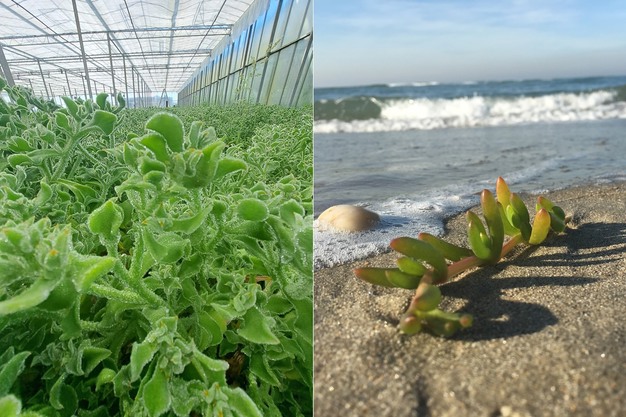The sea vegetable season is in full swing at Elenbaas Zeegroenten. "It's a completely different year from last year. Back then, we had a disastrous season due to heavy rainfall and had to get rid of excess water; now we're bringing in fresh water," says Hans Elenbaas. "Because of the drought, we need to stay alert for stick or wire contamination in the samphire. So we continue to struggle with nature and the increasingly extreme climate. But we do have larger volumes available than last year and can supply the market reasonably well. We started a bit earlier with sea lavender, and the samphire was even available considerably earlier."

Greenhouse in Kerkwerve
In addition to cultivation along the Zeeland coast, Elenbaas is also increasingly growing sea vegetables in a greenhouse in Kerkwerve, through its separate cultivation company Nieuwe Zilte Zeeuwse Teelten (NZZT). "At the moment, most vegetables still come from the sea, but as demand increases, we'll need to grow more and more sea vegetables on land," Hans continues, noting that the cultivation process is far from simple. "The plants are mostly saline and therefore very delicate. Also, harvesting, sorting, and packaging are still mostly manual tasks. However, we are looking into automation. Last year, for instance, we invested in a new packing machine."

"We grow various types of sea vegetables in our greenhouse. For example, sea bananas have really become the third main sea vegetable after glasswort and sea lavender. We grow sea bananas year-round in our own greenhouse, without heating. The advantage is that they're always juicy and have a long shelf life. Sales of these have really taken off; our figures have tripled this year compared to last year."

Hans among the sea bananas in the greenhouse
Other vegetables grown in the greenhouse include iceweed and sea fennel. "With iceweed, it's still a challenge to ensure year-round supply, but we're getting a better handle on the cultivation process. It has a truly salty-sour flavour," says Hans. "We can now also grow sea fennel well in the greenhouse. We sell a lot of it fresh to the hospitality industry, but sea fennel has other applications too, for example, it's also used in beer."

Seaweed salad
"We're also working on developing a seaweed salad made from Wakame harvested in the Oosterschelde. We plan to introduce it soon and have already attracted interest from major players," Hans says. "We have many product development ideas, but for now, we've decided to focus mainly on our current range and not expand further."

The care and labour that go into sea vegetables mean the products carry a certain cost. "That's why they often seem expensive, especially as the hospitality sector is under pressure to cut costs. At the same time, we always tell chefs that sea vegetables require very little prep work. You need to cut a cauliflower or broccoli, but samphire, sea lavender, and sea bananas can go straight into the pan."

Zeeland's salty seaweed in the greenhouse and sea banana by the sea
"Until the COVID period, we saw significant annual growth in sea vegetable sales, but that has levelled off since, as the hospitality industry faces mounting pressure. We certainly can't complain, but it does require creativity. Fortunately, we serve a broad customer base, from restaurants to supermarkets, greengrocers and fishmongers, farm shops and even industry. Growing sea vegetables is not easy; we're still learning every day. It remains a niche market, so there's a lot of pioneering involved."

For more information: Hans Elenbaas
Hans Elenbaas
Elenbaas Zeegroenten
Ampereweg 14-18
4338 PT Middelburg
Tel: +31 (0) 118 602200
Mob: +31 (0) 6 51122106
[email protected]
www.zeekraal.nl
